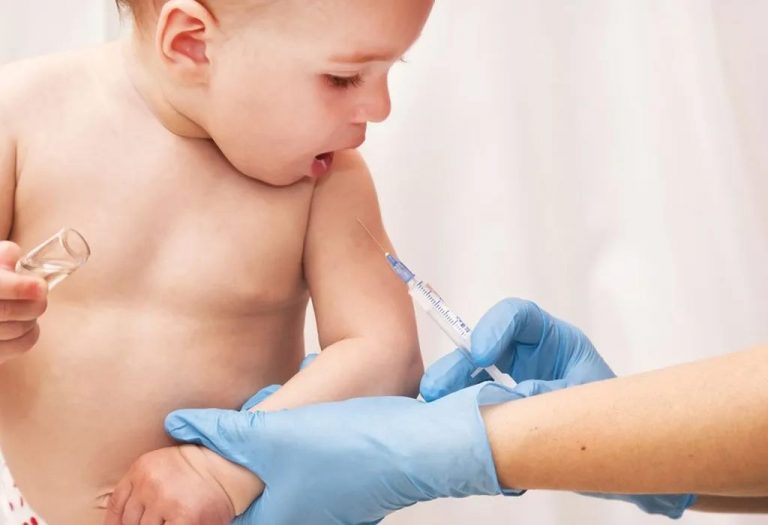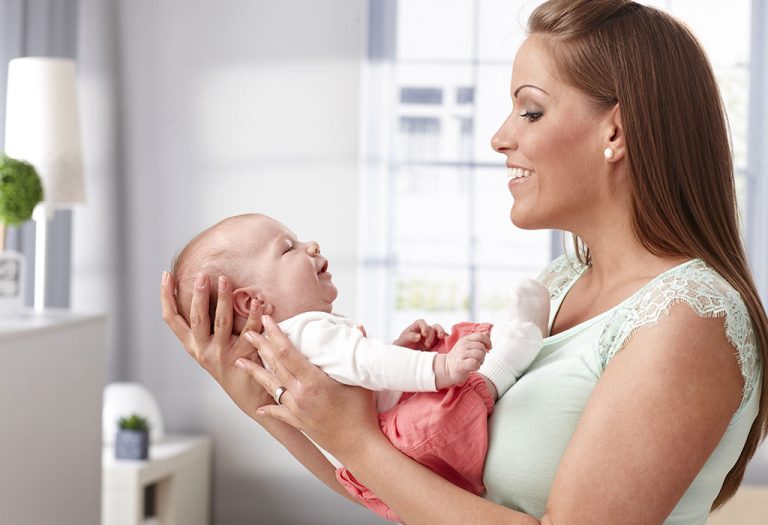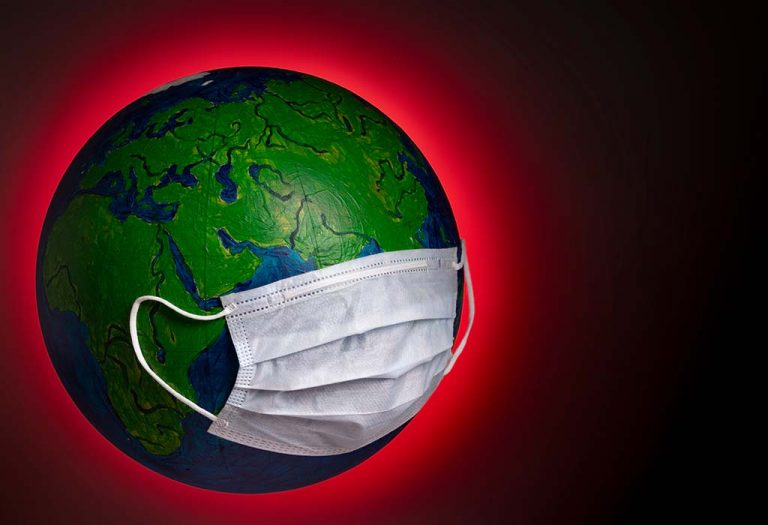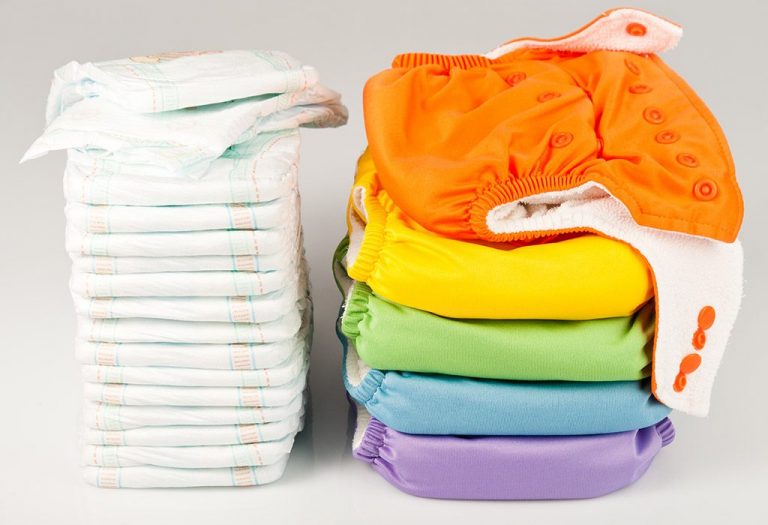Pain After Vaccination in Babies – Tips to Ease It

- 11 Ways to Relieve Your Baby’s Pain After Vaccination
- FAQs
- Infographic: Ways to Ease Pain After Vaccination in Babies
Vaccinations offer protection to your baby from many dreadful diseases. Babies are more vulnerable to viruses as their immune system isn’t completely mature. This increased output of viruses, along with typically lesser attention to hygiene, makes children more likely to spread their infection to others. The possibility of transmission is further enhanced when many children are gathered together, such as in childcare centres and schools. Hence, it is imperative that your baby gets all the recommended shots on time
Many moms become upset on seeing their babies in pain after a shot. Vaccinations are for your baby’s good and shouldn’t be avoided. However, you can certainly make the experience less stressful for your baby. Let’s learn about how to relieve pain after vaccination in babies.
11 Ways to Relieve Your Baby’s Pain After Vaccination
Here are a few things you can do to ease your baby’s pain during and after a shot:
1. Cuddle Your Baby

Cuddle him! Babies calm down and cry less when they’re cuddled by their parents. That’s because familiar touch helps them feel protected.
2. Feed Him
Babies focus on one task at a time, so feeding your baby after vaccination can help take his mind off it and also lower the pain considerably. Breastfeeding your baby more often after the vaccination will also keep him hydrated and prevent fever from setting in.

3. Distract Him
Calm baby after shots by distracting him with his favourite toy while he’s getting injected. This can help to keep his mind off the pain.
4. Apply a Cool Compress/Ice Pack to the Injected Area
A cool compress can reduce the swelling or soreness at the site of the injection. Soak a cloth in cold water and place it on the injected area. You can also use an ice pack instead to relieve the pain.
5. Inquire About Numbing Creams
You can ask your paediatrician to use a numbing cream or spray before the injection. It’s best if you clarify this beforehand as you may need a prescription for the same.
6. Opt for a Painless Injection

Painless injections or an acellular vaccine, as opposed to whole-cell vaccines, cause no symptoms and little or no pain, as they come with fewer antigens. You can ask your doctor if this option is available and decide if you would prefer to go for it.
7. Check for Combination Shots
Vaccinations for different diseases can be combined together in a single shot to reduce the number of injections that your baby has to take. You can check with your paediatrician about this.
8. Rub Your Baby’s Skin
Gently massaging the area surrounding the injected area before and after an injection can relieve the pain.
9. Stay Calm
Your worrying will only fuel your baby’s fear and make him distressed. Stay calm as you hold your baby, to prevent him from feeling stressed.
10. Use the 5 Ss Approach
You can also use these 5 Ss to calm your baby down after a shot.
- Swaddle him immediately after vaccination.
- Place him on the side or the stomach
- Make shushing sounds
- Swing him in your arms or an infant swing
- Give him something to suck, for example, your breast, a milk bottle or a pacifier
11. Inquire About Pain-Relief Medication
If your baby cries a lot due to the pain or develops a fever after getting a shot, you can speak to your paediatrician about giving medication like acetaminophen or ibuprofen for pain relief. Treating baby fever after vaccination is imperative.
FAQs
1. Why does my baby experience pain after vaccination?
Babies often experience pain after vaccination due to the body’s natural immune response to the vaccine. The vaccine introduces a small, safe part of the virus or bacteria into the body, prompting the immune system to respond and build protection against the disease. This response can cause discomfort, including pain at the injection site, as well as potential swelling or redness. These symptoms are generally mild and indicate that the vaccine is effectively stimulating the immune system.
2. How long does the pain last after vaccination?
The pain or discomfort after vaccination typically lasts for a couple of days, though every baby reacts differently. Some may experience very mild symptoms, while others may seem more affected. It’s common for babies to have a low-grade fever, appear a little fussier than usual, or have slight swelling at the injection site during this time. If symptoms persist beyond 48-72 hours or if you have any concerns about your baby’s well-being, it’s important to contact your pediatrician.
3. Can I bathe my baby after vaccination?
Yes, you can bathe your baby after vaccination, but it might be wise to wait a few hours before doing so. Some babies may experience tenderness at the injection site, and handling the area too soon could cause discomfort. When you do bathe your baby, check the injection site for any signs of redness or swelling, and be gentle. If the site seems particularly sensitive, a sponge bath might be a more comfortable option until the tenderness subsides.
4. Is it normal for my baby to be fussy after receiving a vaccine?
Yes, it’s quite normal for babies to be fussier than usual after getting vaccinated. This fussiness is generally due to discomfort or pain at the injection site, as well as a possible low-grade fever, which are common reactions to vaccines. These symptoms are usually mild and temporary. You can soothe baby after vaccines with comforting strategies, such as swaddling, skin-to-skin contact, or gently rocking your baby, can help alleviate their distress. If your baby seems excessively uncomfortable or the fussiness persists, consult your pediatrician for advice.
This was all about how to help baby after vaccine shots. It is important for your baby to get vaccinated as it is the best form of protection against life-threatening diseases. So, stay calm and remember that your baby will feel the prick only for a little while. With the above steps, you can try to make the experience less distressing for your baby.
Infographic: Ways to Ease Pain After Vaccination in Babies
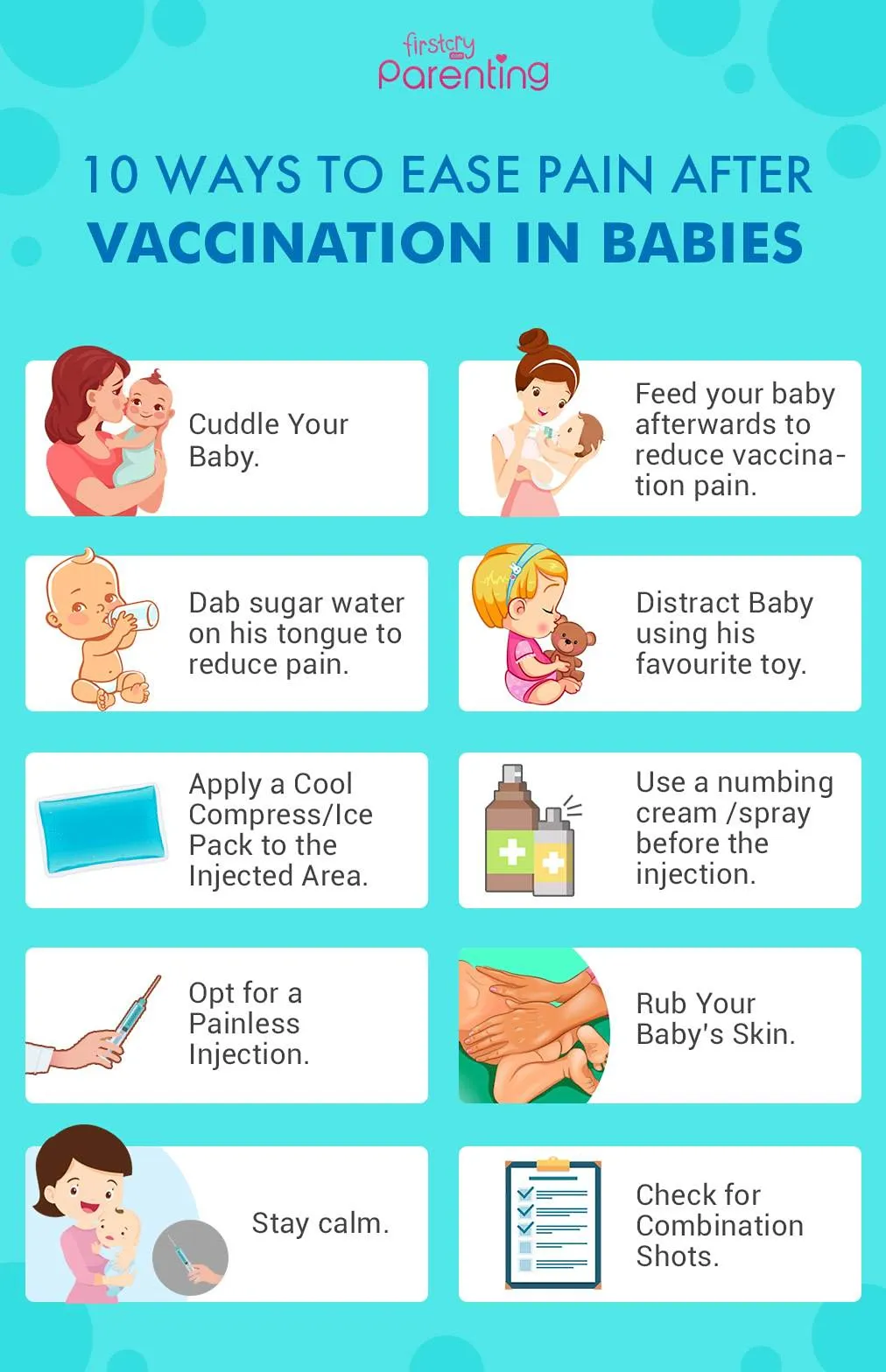
References/Resources:
1. How Can I Comfort My Baby During Shots?; Nemours Kids Health; https://kidshealth.org/en/parents/baby-vaccinations.html
2. Reducing the pain and anxiety of vaccination in children; Québec; https://www.quebec.ca/en/health/advice-and-prevention/vaccination/reducing-pain-and-anxiety-of-vaccination-children
3. Pain Management During Immunizations for Children; Immunize Canada; https://immunize.ca/pain-management-children
4. Immunisation – side effects; Better Health Channel; https://www.betterhealth.vic.gov.au/health/healthyliving/immunisation-side-effects
5. Immunization Reactions; Seattle Children’s Hospital; https://www.seattlechildrens.org/conditions/a-z/immunization-reactions/
6. Vaccinations; Centres for Disease Control and Prevention; https://www.cdc.gov/breastfeeding/breastfeeding-special-circumstances/vaccinations-medications-drugs/vaccinations.html
7. Garg, N, Aggarwal. A; Advances Towards Painless Vaccination and Newer Modes of Vaccine Delivery (Indian Journal of Pediatrics); National Library of Medicine; https://www.ncbi.nlm.nih.gov/pmc/articles/PMC7090876/; June 2017
Also Read:
Common Side-Effects of Vaccination in Babies
Vaccine Myths and Facts You Should Consider
Can Babies Have Vaccinations With a Cold or Cough?
Commonly Asked Vaccination Questions with Answers
Was This Article Helpful?
Parenting is a huge responsibility, for you as a caregiver, but also for us as a parenting content platform. We understand that and take our responsibility of creating credible content seriously. FirstCry Parenting articles are written and published only after extensive research using factually sound references to deliver quality content that is accurate, validated by experts, and completely reliable. To understand how we go about creating content that is credible, read our editorial policy here.







